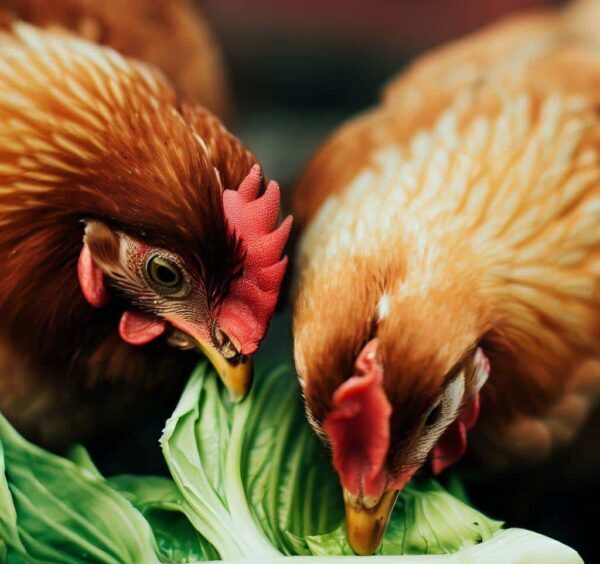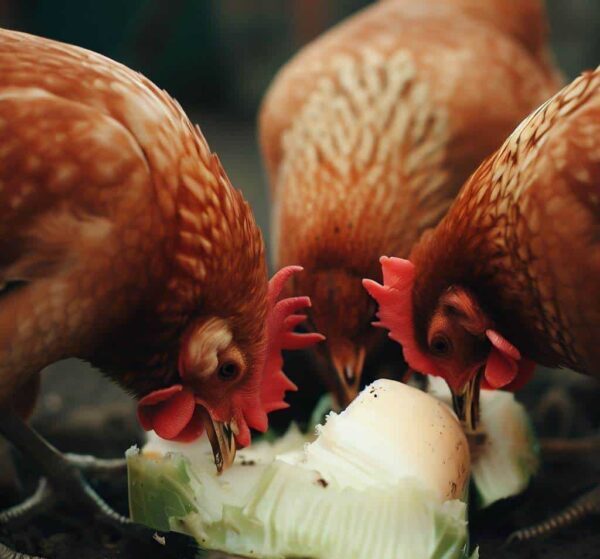Dixie Rainbow Chicken | A Colorful Breed Profile (245+ Eggs)

Dixie Rainbow Chickens are a colorful type of chicken that is large in size, dual-purpose, wonderful mothers and has a unique feather color.
These colorful baby chicks are perfect for adding a pop of color to your homestead.
These unique chickens lay brown eggs and are becoming popular among poultry enthusiasts.
If you want to spice up your flock, consider welcoming the Dixie Rainbows into your life.
Quick Breed Overview
| Particulars | Value |
|---|---|
| Name | Dixie Rainbow |
| Breed Type | Dual-Purpose |
| Egg | |
| – Size | Medium to Large |
| – Color | Light Brown |
| – Quantity | 225-250 Per Year |
| Weight | |
| – Mature Weight | 6-8 lbs (Pounds) |
| – Maximum Observed | 15 lbs (Pounds) |
| Life Span | 3-7 years (ideal care: 10-12 years) |
| Maturity Period | 12-13 Weeks |
Topics Covered In This Article
- What Are the Physical Features Of Dixie Rainbow Chickens?
- What Is the History And Origins Of Dixie Rainbow Chicken?
- What Is the Purpose Of Owning A Dixie Rainbow Chicken?
- How Many Eggs Can Dixie Rainbow Chickens Produce?
- What Are the Varieties Of Dixie Rainbow Chicken?
- What Is the Temperament And Behavior Of Dixie Rainbow Chicken?
- How To Take Care Of A Dixie Rainbow Chicken?
- What Are the Benefits Of Raising A Dixie Rainbow Chicken?
What Are the Physical Features Of Dixie Rainbow Chickens?
Dixie Rainbow chickens are large birds that have a standard pattern of tan/brown and speckles. Some are even found to be white or pale brownish.
Some of them are more golden brown, while others have a light tannish brown color with hints of blue, black, and red feathers. They are known for their vibrant colors, resembling rainbows.
In terms of size, Dixie Rainbow, including roosters and hens, reaches market weight at around 12-13 weeks old. At this time they are known to develop fully grown wattles and combs.
They grow excessively quickly, allowing them to reach a mature weight of 7-8 pounds.
Each bird, with their feathers, boasts multiple colors, making them a delightful sight to behold. These birds lay brown eggs and are often accompanied by roosters.
No two birds look alike, with each one showcasing its own distinct pattern of feathers and combination of hues.
However, their large size and feathers make them less aerodynamic compared to other chicken breeds.
These robust roosters and hens may not be suitable for small children to handle comfortably or safely due to their size and shape.
You can also read our Black Orpington Chicken Article if you are looking for something dark in color.
What Is the History And Origins Of Dixie Rainbow Chicken?
They are a hybrid breed that originated from crossing different breeds of chickens, such as Cornish, White Rock, New Hampshire, and Rhode Island Red.
They were developed in Europe several years ago and later introduced to the US by S and G Poultry.
The brown Dixie Rainbow hens were created in recent years by backyard chicken enthusiasts who wanted to introduce a new level of beauty to their flocks.
Breeding programs for the Dixie Rainbow Chicken focused on aesthetics, temperament, egg-laying abilities, and overall health.
Breeders created a visually striking and functional chicken by selectively breeding brown hens from different heritage breeds.
What Is the Purpose Of Owning A Dixie Rainbow Chicken?
Dixie Rainbow is a dual-purpose chicken which means that you can use it for both egg production and as meat birds.
If you are looking for an egg-producing bird then Dixie Rainbow might be the one for you as it produces 225-250 eggs per year.
Primarily bred for their striking appearance, they bring color and joy to any backyard or farm.
These birds have vibrant plumage, with a mix of patterns resembling a rainbow, adding an eye-catching element to the surroundings.
They also excel in egg production, making them a practical choice for those seeking hens who consistently lay eggs.
Whether it’s summer heat or winter chill, these chickens maintain their egg-laying ability all year round.
Their large-sized bodies, crossbreeding heritage, and the use of dixie rainbows contribute to their ability to consistently lay eggs.
For people who want both beauty and utility in their flock, Dixie Rainbow Chickens hit the mark.
How Many Eggs Can Dixie Rainbow Chickens Produce?
Dixie Rainbow hens can produce approximately 225-250 brown eggs per year Once they begin laying
These birds typically start laying eggs between 20-24 weeks of age, making them fairly early producers compared to other breeds.
These large eggs are highly sought after for their rich flavor and aesthetic appeal.
They are known for their excellent egg-laying capabilities and can also be raised for meat production.
However, it’s important to note that egg production can vary throughout the year for Dixie Rainbows.
During winter months, these Dixie Rainbows chickens tend to ramp up their egg-laying efforts, resulting in an abundant supply of fresh brown eggs.
On the other hand, as summer arrives for Dixie Rainbows, there is often a sudden drop in egg production due to heat and various environmental factors.
What Are the Varieties Of Dixie Rainbow Chicken?
Dixie Rainbow chickens come in a wide range of color variations, giving poultry enthusiasts plenty of choices to suit their preferences.
Breeders have been continuously experimenting with new color combinations for the Dixie Rainbow chickens.
This ongoing innovation ensures that there is always something fresh and exciting for chicken lovers to discover.
Whether you’re looking for striking reds, captivating blues, or soothing greens, these colorful chickens offer a visual treat for anyone who appreciates the beauty of nature.
Dixie Rainbow chickens can adapt well to different climates.
So whether you live in a hot and humid area or a cooler region, these chickens can be an excellent choice for your flock.
If you consider adding Dixie Rainbows to your flock alongside other breeds, they can get along well with popular choices like Wyandottes, Brahmas, and Faverolles.
Their friendly nature makes them great companions for other breeds and ensures harmony within the coop.
What Is the Temperament And Behavior Of Dixie Rainbow Chicken?
Dixie Rainbow Chickens are affectionate and sweet wonderful mothers who are fully committed to hatching and raising their young chicks.
Known for their hardiness and ability to thrive in various weather conditions.
They do well in confined and in free-cage so any type of environment can be suitable for them.
They also get along well with other breeds and are popular among chicken enthusiasts.
These chickens are active foragers and enjoy exploring their surroundings for insects and plants to eat.
They thrive in various weather conditions without any issues.
Dixie Rainbow chickens are known for their friendly and non-aggressive behavior toward humans and other chickens.
Some are also known to be very vocal to their owners.
They make excellent companions for different breeds and are adaptable to various settings, from small backyards to larger farms.
With their pleasant personality and instincts as active foragers, they are a great addition to any flock.
How To Take Care Of A Dixie Rainbow Chicken?
Dixie Rainbow chickens require standard care similar to other chicken breeds.
They need access to fresh water, nutritious feed, shelter, and regular health checks.
Here are some key points to consider for their care and maintenance:
- A balanced diet must be provided that includes quality chicken feed to ensure proper growth and development.
- Fresh water should always be available to keep the chickens hydrated.
- A suitable coop that protects them from predators and extreme weather conditions and provides enough space for comfort
- Regular health checkups to monitor chickens’ well-being.
- The coop should be regularly cleaned to maintain good hygiene and prevent the spread of diseases.
- They are calm creatures which makes them easy to handle and is perfect for families with children.
By following these guidelines, you can ensure that your Dixie Rainbow chickens receive the care they need to thrive on your homestead while enjoying their vibrant beauty and delightful personalities.
What Are the Benefits Of Raising A Dixie Rainbow Chicken?
Some benefits of raising dixie rainbow chickens are:
- A vibrant and colorful addition to your backyard flock
- Low maintenance breed, perfect for beginners
- Stunning appearance with feathers ranging from buff and gold to chocolate and cold
- Provides a steady supply of eggs throughout the year
- Impressive growth rate, reaching maturity in just a few weeks
- Bred from popular heritage breeds, resulting in a hardy bird that can thrive in various climates and environments
Dixie Rainbow Chicken: Key Takeaways
The Dixie Rainbow Chicken is a versatile breed that offers many benefits.
It is known for its good health and ability to adapt to different environments.
These chickens lay a lot of eggs all year round, making them perfect for people who want fresh eggs regularly.
They also come in different colors and have unique feather patterns, which makes them look nice.
These chickens are friendly and get along well with people and other pets.
To take care of them, you need to give them a proper coop, good food, clean water, and regular vet check-ups.
If you want a healthy breed, lays lots of eggs, looks nice, is friendly, and is easy to take care of, choose the Dixie Rainbow Chicken!
Frequently Asked Questions (FAQs)
No special medical attention is required for Dixie Rainbow Chickens as they are bred to be healthy and hardy. However, regular veterinary check-ups are recommended to ensure their well-being.
On average, a Dixie Rainbow Chicken can lay approximately 225-250 eggs per year, depending on factors such as diet and environmental conditions.
Yes, Dixie Rainbow Chickens have a friendly temperament and can be great companions for children. However, supervision is always recommended when young children interact with chickens.
Yes, Dixie Rainbow Chickens can adapt well to urban settings as long as local regulations permit backyard chicken keeping. Ensure you provide them with a suitable coop and consider noise levels for your neighbors.
While they have no specific dietary requirements, it’s important to provide a balanced diet consisting of commercial feed supplemented with fresh fruits, vegetables, and clean water.
Last Updated on 28 February 2024
Waman Nuka is a seasoned wordsmith and a passionate animal enthusiast with decades of experience in the world of animal care. With a deep love for all creatures great and small, Waman’s journey in the realm of animals started as a young boy exploring the lush forests surrounding his childhood home.


